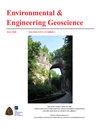加利福尼亚森林瀑布区泥石流沉积、切割和河道迁移导致的冲积扇蚀变
IF 1
4区 工程技术
Q4 ENGINEERING, ENVIRONMENTAL
引用次数: 1
摘要
在圣贝纳迪诺山脉的森林瀑布镇,使用各种实地方法(绘制发生后的流动事件,树木年代学证据,土壤年代学序列)重建了泥石流的历史模式。当夏季雷暴产生短暂的高强度降雨动员碎屑时,会发生大流量事件;然而,地貌系统表现出非线性响应的特性,而不是单一事件降水驱动的过程。以往的研究将夏季变强度雷暴产生的水流相对含水量与控制流速和沉积路径的模型因素进行了对比。我们假设该地貌系统的输沙量具有多种复杂来源,并提供了以下证据:(1)基岩峡谷上游输沙量的阈值,(2)基岩峡谷下游输沙量的储存效应,以及(3)动态河道填充、切割和撕裂过程中冲积扇沉积、再动员和输沙量的反馈。第一个组成部分的一个例子发生在2017年3月,当时融雪产生了约8万立方米的快速平移滑坡和碎片雪崩;这些沉积物沉积在基岩峡谷中,但没有进一步向下移动。第二个组成部分观察到,当基岩峡谷中积聚的亚稳定沉积物保持在原地,直到河流侵蚀和随后的泥石流提供了动态不稳定性,以重新动员下游的质量。第三个组成部分发生在基岩峡谷下方的冲积扇上,在那里,低含水量的泥石流沉积了沉积物,填满了活动河道,将河道的坡度提高到堤坝的高度,允许随后非河道化的水流扩散到扇表面,并冲刷出新的河道路径。提出了泥石流系统时空复杂性的概念模型,以指导未来的研究,以改进风险预测。本文章由计算机程序翻译,如有差异,请以英文原文为准。
Alluvial Fan Alteration Due to Debris-Flow Deposition, Incision, and Channel Migration at Forest Falls, California
Historical patterns of debris flows have been reconstructed at the town of Forest Falls in the San Bernardino Mountains using a variety of field methods (mapping flow events after occurrence, dendrochronology evidence, soil chronosequences). Large flow events occur when summer thunderstorms produce brief high-intensity rainfall to mobilize debris; however, the geomorphic system exhibits properties of non-linear response rather than being a single-event precipitation-driven process. Previous studies contrasted the relative water content of flows generated by varying-intensity summer thunderstorms to model factors controlling flow velocity and pathway of deposition. We hypothesize that sediment discharge in this geomorphic system exhibits multiple sources of complexity and present evidence of (1) thresholds of sediment delivery from sources at the higher reaches of bedrock canyons, (2) storage effects in sediment transport down the bedrock canyons, and (3) feedbacks in deposition, remobilization, and transport of sediment across the alluvial fan in dynamic channel filling, cutting, and avulsion processes. An example of the first component occurred in March 2017, when snowmelt generated a rapid translational landslide and debris avalanche of about 80,000 m3; this sediment was deposited in the bedrock canyon but moved no farther down gradient. The second component was observed when accumulation of meta-stable sediments in the bedrock canyon remained in place until fluvial erosion and subsequent debris flow provided dynamic instability to remobilize the mass downstream. The third component occurred on the alluvial fan below the bedrock canyon, where low-water-content debris flows deposited sediments that filled the active channel, raising the channel grade level to levee elevation, allowing for subsequent spread of non-channelized flows onto the fan surface and scouring new channel pathways down fan. A conceptual model of spatial and temporal complexities in this debris-flow system is proposed to guide future study for improved risk prediction.
求助全文
通过发布文献求助,成功后即可免费获取论文全文。
去求助
来源期刊

Environmental & Engineering Geoscience
地学-地球科学综合
CiteScore
2.10
自引率
0.00%
发文量
25
审稿时长
>12 weeks
期刊介绍:
The Environmental & Engineering Geoscience Journal publishes peer-reviewed manuscripts that address issues relating to the interaction of people with hydrologic and geologic systems. Theoretical and applied contributions are appropriate, and the primary criteria for acceptance are scientific and technical merit.
 求助内容:
求助内容: 应助结果提醒方式:
应助结果提醒方式:


